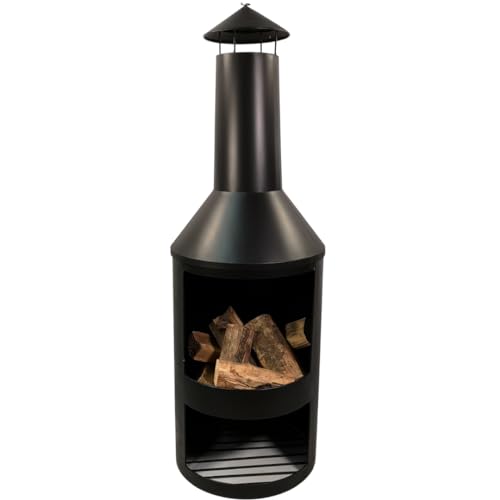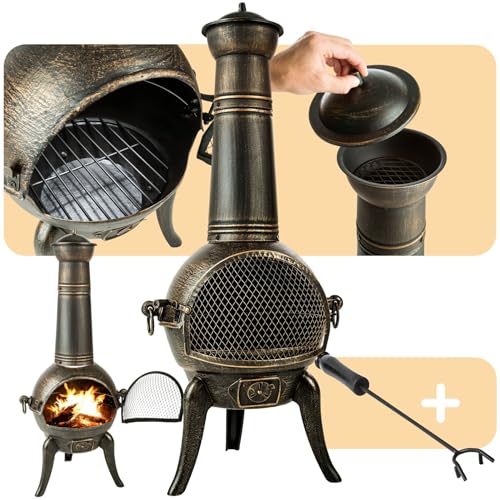The History Of Chiminea Fireplaces
페이지 정보

본문
 Chiminea Fireplaces
Chiminea FireplacesFire pits are great, but chimineas offer an entirely new perspective to fire pits in the backyard. These unique outdoor fire places are art pieces, providing warmth and ambience for your family gatherings.
Chimineas should be kept outdoors and not placed directly beneath any material that is flammable. They must be kept away from rainy weather.
Safety
It is crucial to take safety precautions regardless of the type of fire feature you have in your backyard. Both Fire pits and chimineas; planforexams.com, are prone to generating hot sparks, which can cause burns. They also both emit an ash plume that may contain pollutants, including secondhand tobacco smoke. Ensure that the surrounding area is free of anything that could ignite and that the chiminea is located away from trees that are overhanging or eaves that could catch fire. Also, it's recommended to wear a protective suit when using a chiminea, particularly if you intend on cooking food on it.
Although both chimineas and pits can provide warmth, entertainment and a focal point to your outdoor space however, they differ in regards to aesthetic preferences and lifestyle needs. Fire pits have a more dramatic appearance and can be used to complement a wide variety of design styles. Chimineas provide an older, more rustic appearance and are perfect for smaller gardens. They also require a bit more care, since they tend to produce more smoke than fire pits, and require regular cleaning of ash.
In terms of environmental impacts are concerned, chimineas release less pollutant particles than traditional fireplaces that burn wood because they make use of dry well-seasoned, seasoned and smoky wood, which results in less emissions per unit of use. Both kinds of fire pits can release large quantities of air pollutants most often in the form of harmful chemicals.
When setting up a chiminea, be sure to use only wood that is seasoned and to keep the burning flames small. It's also a good idea to install an electrical spark arrester made of mesh on the top of the chimney. A spark arrester can reduce the amount of sparks that are produced, which could ignite grass fires and spread the flame into nearby combustible material. It's important not to extinguish a chiminea using water, since the sudden change in temperature could crack terracotta or clay and harm metal.
Both fire pits and chimineas are best suited to a fire-safe surface like pavers, concrete, brick, or slate tiles. The ceramic chiminea must be at least 10 feet away from any structure or combustible materials. It's also an excellent idea for homeowners to buy a water hose or a container so they can quickly end any fires that may get out of control.
Style
Although fire pits have become extremely popular and could be the most common option for outdoor fire features, chimineas remain popular with homeowners. They can be a great way to add rustic or Mexican feel to your patio or garden as well as offer warmth in the cooler winter months. You should decide between a chiminea or a fire pit depending on the size of your outdoor space as well as the kind of fuel you want to use.
Chimineas are available in a variety of designs, ranging from the classic terra-cotta round design to more modern metal options. Some allow you to burn gas rather than wood and are a great alternative in the event that the weather turns cold or it's just too windy for an open fire.
The base of a traditional chiminea is hollow and holds the firewood. This wood is fed from the front. The chimney neck extends up and away from your home and away from drafts. This helps to reduce soot and prevents it from getting into food items or on you when cooking.
Chimineas made of clay and terra-cotta can be damaged if they become too hot, which is why they work best chiminea in spaces which are protected from elements. Cast iron and steel chimineas can endure heat, but they are heavy and difficult to move.
A wood-burning chiminea can be an ideal addition to your patio, especially when there is plenty of space to put it. Keep in mind that chimineas require lots of space for smoke, so it is important to put them far enough away from any other structures or seating areas to prevent the risk of damage and also to stop the ash from blowing onto people's faces.
Chimineas are made from metal or clay and will be either painted or natural-looking. If you select metal chimineas, they will most likely have a protective coating that assists to repel rust. Some models even have an black finish to give them an elegant look. You can also pick one with a genuine rust patina, which develops naturally as the metal is exposed to elements.
 Fuel
FuelWith a broad base that taper to a narrow chimney chimineas provide the perfect focal point for smaller patios. With a variety of materials and handcrafted detailing, these fireplaces elevate the appearance of any deck or backyard, adding warmth and ambience to any outdoor living space.
In contrast to traditional fireplaces that burn wood that emit a large deal of smoke and can pose health risks, chimineas are designed to limit harmful emissions. The enclosed design and upward-directed fireplace reduce the amount of smoke that is released, thus reducing environmental issues and neighbourly complaints. This is especially beneficial when you live in an urban area where excessive smoke could cause problems for those nearby.
Chimineas typically burn treated or seasoned wood, but you can find models that can also use charcoal and propane gas for a more diverse cooking experience. If you choose to burn fossil fuels, such as coal, you will need to watch the fuel you use to ensure that it doesn't produce too much smoke.
Like fire pits, the size of chimineas is also different. There are a variety of designs to fit standard logs, or even larger pieces to grill. Certain chimineas feature features like grilling grates, a screen or a rain cap to shield the chimney from falling sparks and other debris. Some, like this model from Bali Outdoors, include a mouth opening that is screen-screened and a wood poker made from steel for safely igniting the fuel.
Whether you prefer an edgier or modern design, there's bound to be a chiminea that will fit your preferences. You can find chimineas with detailed or engraved designs as well as traditional models. Some manufacturers, such as the Blue Rooster Company, which makes our top choice, offer conversion kits that convert chimineas burning wood to gas-powered models.
Selecting the right chiminea for your needs is essential for a comfortable and safe experience in the garden. To determine which one is ideal for you, consider your lifestyle, your aesthetic preferences and the dimensions of your garden. When shopping, make sure you prioritize safety features and maintenance requirements. Also, consider your budget so that you can enjoy your chiminea with grill throughout the year.
Maintenance
Although chimineas are simple to use, they require some attention to ensure their long life and safety. Keep your chiminea free from debris and ash to avoid structural damage and fire hazards. Regularly cleaning the appearance of your fireplace outside and adds rustic charm.
Gas models can be easily converted to burn propane or natural gas. To prevent carbon monoxide poisoning it is important to ensure that the chimney is free of flammable materials like leaves and twigs when using a gas-powered chiminea. It is also essential to only use dry well-seasoned wood in your gas chiminea modern because treated or painted wood releases toxic chemicals when burned.
It is recommended to fill the clay chiminea's bottom with pea gravel or rock sand. This will prevent the clay from cracking when heated by a large flame. A slate or metal stack top can be positioned on the chiminea in order to shield it from rain. Chimineas need to be cured or broken in slowly by lighting small fires. After three to four small fires, your chiminea should be ready for larger logs.
When using your chiminea it is essential to adhere to local laws regarding burning. In times of drought, be extra cautious as the smoke from your chiminea could cause your neighbors to be upset or ask you to remove the flames.
Both chimineas made of steel and clay may break or crack when the weather is too hot or cold, however steel structures are more susceptible to suffering from corrosion and rust than those made of clay. A durable, high-quality chiminea can help ensure that your outdoor fire will last for many years.
When using your chiminea it is recommended that the grate be filled with around 3 inches of pea gravel to keep the fire from spreading too quickly and posing a fire risk. It is also a good idea to put your chiminea in a place where the wind patterns will move the smoke away from your house and not in it, as the constant stream of noxious fumes could cause issues.
- 이전글Guide To Auto Folding Travel Scooter: The Intermediate Guide To Auto Folding Travel Scooter 24.12.13
- 다음글Wszystko, co musisz wiedzieć o przywracaniu właściwego poziomu witaminy D 24.12.13
댓글목록
등록된 댓글이 없습니다.

